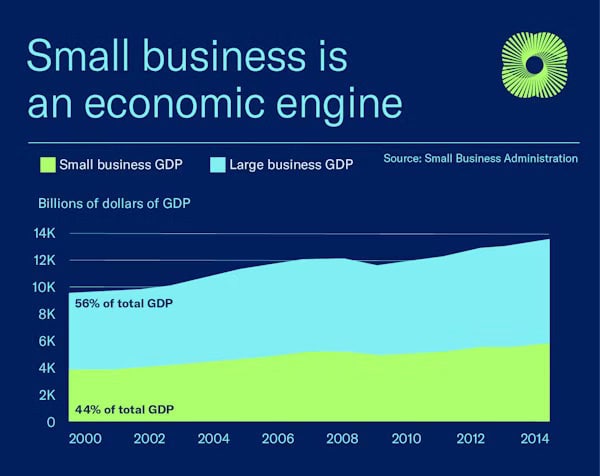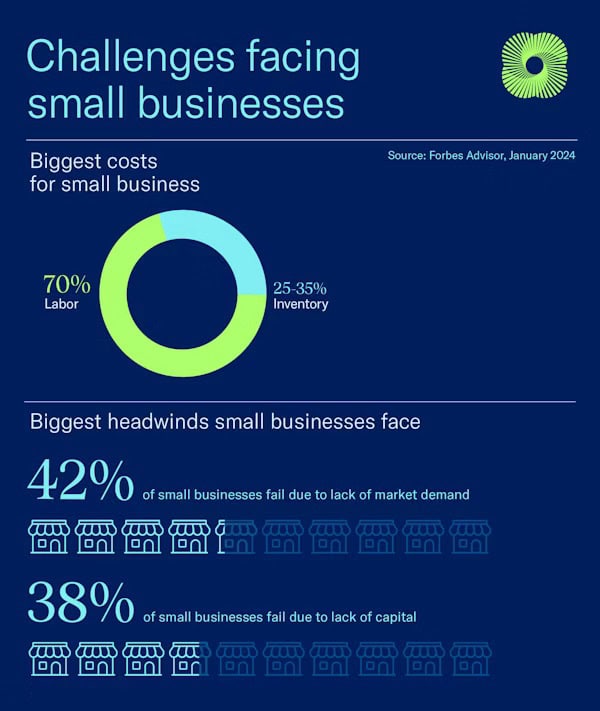Ever daydreamed of turning your living room into a thriving business hub? You’re not alone, and there’s no better time to make that dream a reality. 50% of all small businesses start from home. It’s a low-risk way to kickstart your own business with lower upfront costs.
Depending on your business idea, You could start with as little as $100. At the higher end of the scale, the cost of setting up a home business averages between $2,000 and $5,000.
However, most people get tripped up when validating your idea, securing financing, and getting registration and licenses. Marketing, too, often feels like running a marathon with no one to cheer you on.
If you want a ‘big picture’ road map that puts it all into perspective, this post is for you.
Let’s get started.
Table of Contents
Key Takeaways
- Starting a home business can be low-cost—imagine launching your dream venture with as little as $100. We’ll guide you on how to take that first affordable step.
- Learn how to make your schedule work for you—running a home business lets you call the shots on when and where you work. We explore how to make it fit your lifestyle.
- Discover the best tools to scale your home business—like how Ashley Reynolds turned leftover supplies into a thriving subscription box service.
- Marketing doesn’t have to cost a fortune—even a simple website or strategic Instagram posts can help grow your audience. Learn effective budget-friendly strategies here.
- Ready to handle bookkeeping and taxes? We cover essential tips for managing your finances from home, making it easier to stay on top of things.
What Makes Home Businesses So Appealing?
Let’s look at how a home business is different from traditional models and what makes it a popular option for entrepreneurs:
What is a home business?
A home business is just what it sounds like – a business that operates from an apartment or house instead of an office building. They come in all shapes and sizes – one-person businesses, partnerships, LLCs, or corporations. You could be self-employed or have dozens of employees working for you.
Home businesses are not limited to brick-and-mortar operations like gardening, bakery, or pet grooming, though.
Thanks to the internet, a large number of people are now online. This includes businesses like personal trainers, virtual assistants, coders, digital marketers, professional consultants, freelance writers, life coaches, etc.
Pros and cons of starting your business from your home
Starting a home business lets you jump into the market without putting too much at stake. Here are some advantages and disadvantages:
Test your business idea
50% of small businesses fail within 5 years. The reasons range from no market demand to poor marketing. A home business allows you to test your product or service in the real world but on a smaller scale. Based on market feedback, you can iterate and optimize your business model before investing big money.
Low cost
Starting a business from home can save you thousands of dollars in fixed and recurring costs like rent, utilities, and office equipment. You get to use your own phone, internet, and office equipment – and claim it as a business expense on your tax form!
Depending on your business, all you might need upfront is some business stationery, website hosting, and registration, and you’d be all set.

Sell globally
Thanks to online marketplaces like Shopify and social media platforms like Instagram or LinkedIn, you can go from local to global in no time, pitching to clients across the world. By building a personal brand, you can have an engaged community before launching products or services tailored to their needs.
Time freedom
As a home business owner, you can fit your schedule around your personal or family commitments and not the other way around.
But it’s not all easy—let’s talk about some of the challenges you might face.
Ineffective lead generation
Growing your brand using organic content and emails can be slow, but it’s worth the effort. While you can use paid ads to drive traffic to your business, most small business owners don’t have a cohesive strategy for lead generation. This results in lost opportunities and poor ROI.
Keep records
If you’re just starting out, you may not have enough sales or revenue to justify hiring an accountant. Despite your best efforts, keeping track of invoices, proposals, bank accounts, taxes, etc on your own can be overwhelming.
Paying taxes
If you’re doing your own bookkeeping, you may have trouble reconciling your income and expenses, especially during tax season. While you can learn how to do it right over time, missing transactions or duplicate entries can mean paying more in taxes.
Hiring employees
Depending on your business model, you’ll need full-time employees at some point. Managing team schedules, payroll, benefits, and supervising work can take up a lot of the time.
Read more: 17 Fab Ideas for eCommerce Business in 2024
Step-by-Step Guide to Launching Your Home Business Successfully
In this section, we’ll break down the different aspects of starting a home business – from selecting the right business idea to scaling it to new heights.
Planning your home business
Planning your home business starts with identifying the problem you want to solve for your customers. The first step is to:
Choose the right business idea
Depending on your skills, interests, and work experience, shortlist two or three ideas with potential. Next, research the market to see if there’s a gap in demand versus supply that you could realistically fill.
The best way to confirm your data is to reach out to people in the industry you’re interested in and get honest feedback. Depending on your financial situation, pick an idea that can be scaled without investing too much upfront.
Create a business plan
Next, it’s time to condense your research on product/service, market size, budget estimates, business operations, and revenue into a simple business plan. It should provide a broad overview of key aspects so that potential investors or partners can gauge the potential of your idea.
Read more: 41 Top Small Business Ideas for 2024: Your Road to Success
Home business registration
Depending on whether you’re going it alone or partnering with others, you’ll need to register your business as a sole proprietorship, limited partnership, LLC, or corporation. Weigh the pros and cons of each carefully.
After all, the business structure you choose will impact your taxes and financing options. You’ll need to apply for a general business license and health and safety permits based on the nature of your business.
Contact your local chamber of commerce or SBA advisor for professional advice.
Read more: 12 Creative Small Business Marketing Ideas That Work
Home business startup costs
While you may not need to pay rent, you must budget for other one-time and recurring costs like registration and licensing, office equipment, hiring, etc – especially during the first 6 months of starting up.
The key is to ensure cash flow without impacting day-to-day expenses. Plan your budget based on how long you think it might take to reach profitability.
Read more: 25+ Brilliant Small Business Tools for the Internet Champion
Setting up a home office
Carving out space for a home office can be a challenge. Compare different locations like the living room, porch, or basement, based on noise, natural light, temperature, etc.
Consider how these factors could impact your productivity, efficiency, and client or employee interactions. A key part of this is setting healthy boundaries, including work hours, child care, chore management, dealing with employees or vendors, etc.
This calls for:
- Clear communication with family and co-workers
- Scheduling team meetings, breaks, and client calls strategically
- Planning and delegating tasks effectively to maintain work-life balance
Marketing your business
Having a website is a must for any home business, even offline ones. It allows you to take appointments or orders without getting on the phone with customers. The good news is you don’t have to spend much on a professional website.
A basic WordPress website with the right features can work just fine. If you don’t have technical skills, consider using a website builder like Squarespace or Wix. These platforms also provide hosting, plug-ins, updates, and other features, which is a plus.

Leveraging social media and landing pages for lead generation
How do you connect with potential customers on social media? Sharing case studies or testimonials from existing customers can be a great first step.
Use high-quality product images in your posts and highlight the benefits. Set up dedicated landing pages with how-to videos to show visitors how to get the most out of your product.
This helps you build trust, drive email sign-ups, and engage subscribers with targeted promotions.
Read more: The Ultimate Guide to Marketing Automation for Small Businesses
Scaling your home business
As the business grows, automating the lead-to-order workflow becomes important. Often, the cost is a barrier. This is where software tools like EngageBay come in.
For example, it can help you create customer profiles, track sales efficiently, and streamline invoice generation via customizable invoice templates.
EngageBay also provides comprehensive customer support features that allow small teams to do more with less effort.
Innovative work-from-home business ideas for 2024
A home business can be adapted more easily to market opportunities than a larger corporation. Here are some case studies of entrepreneurs that have made an impact in recent years:
Subscription box service: Cloth and Paper
If you’ve ever struggled with managing excess inventory, Cloth and Paper’s innovative solution will certainly inspire you.
Niche product
Ashley Reynolds is the brains behind Cloth and Paper, a brand that makes paper planners and journals. Her subscription box service packaged excess inventory with accessories like pens, calendars, or post-it notes, turning it into a niche offering.
This allowed the brand to appeal to customers with different preferences in terms of functionality, aesthetics, etc.
Lean operations
When she started out, Ashley kept costs low by doing the designs, printing, and marketing herself, even learning graphic design along the way.
Marketing strategy
Ashley started posting on social media planner groups and soon built a loyal fan following with her authentic content. Curiously, she didn’t start running paid ads until years later and initially kept her budget under $1000 until she could figure out her targeting strategy.
Hiring
Ashley hired a professional designer to help streamline production and find suppliers as the business grew. Before she expanded her team further, she hired an HR executive who helped her set up a streamlined process.
This allowed her to find and engage the right talent despite having no hiring background herself. Ashley also added a customer support function to manage customer expectations better.
Read more: Discover the Best Online Business Ideas for 2024: Profitable Paths to Success
Vlogging: Yeung Man cooking
Yueng Man Cooking is a popular vegan channel on YouTube with over 300k subscribers. Its founder, Wil Yeung, had already been running a couple of food businesses when the idea of starting a YouTube food show hit him.
The goal was to promote his products organically and drive sales.
Engagement
When the pandemic struck, Wil’s other businesses stagnated, and he started to invest more time in growing the channel. To his credit, he leveraged customer feedback to improve his content, going from faceless videos to appearing as a host in them.
Monetization
Wil leveraged his YouTube content to create a physical cookbook and an online cooking masterclass, adding new income streams. Wil has also collaborated extensively with other creators in the food and lifestyle niche to increase his reach and revenue.
Content strategy
Using a mix of SEO and value-driven content has paid off well for Wil. He recently crossed 500,000 subscribers. It’s clear from the production quality of his videos that Wil prioritizes quality over quantity.
He posts no more than twice a week, but his engagement scores remain high. One reason for that is his wide range of recipes and cooking techniques, keeping the audience hooked.
Takeaways
- Focus on value-added content in addition to SEO-focused growth
- From the subject matter to format and delivery, content quality is non-negotiable
- Interact with your audience and adapt your strategy based on its feedback
- Repackage your content in different formats to generate more revenue
Read more: Stunning Content: 12 Top Free and Paid Social Media Video Creator Apps
Blogging and affiliate marketing: Wait, But Why
Andrew Finn and Tim Urban are co-founders of Wait But Why, an unconventional blog massively popular among its audience.
Unique niche
Wait, But Why covers everything from science and technology, philosophy, personal development, and more. It’s known for breaking down complex topics into nuts and bolts, with the average post running into several thousand words.
This defies conventional wisdom, which advocates sticking to a single niche and keeping posts short.
SEO performance
Because of this focus on quality, Wait But Why routinely ranks among the top search results for competitive keywords. This has brought more traffic and engagement for the brand over time.
Monetization
Tim Urban has been featured on talk shows, spoken at events, and written several books since launching Wait But Why. The two founders have also added an online store with exclusive merchandise, which is quite popular with the audience.
Engagement
Andrew and Tim typically send updates on new posts to their email list via their newsletter, in addition to posting social media posts. Their traffic is mostly organic, which isn’t surprising given that they have over 300,000 subscribers.
Read also: How to Sell on Etsy in 7 Easy Steps (2025)
Conclusion
Starting a home business might feel overwhelming, but remember, every successful company started somewhere. Take one small step today—whether writing down your idea or setting up your workspace—and keep moving forward. You’ve got this, and we’re here to help every step of the way.
I hope this post has been of value in figuring out your home business game plan. Balancing risk and reward is inherent in any business, and if you’re willing to play the long game and adapt your strategy, you can achieve the financial and lifestyle freedom you seek.
FAQ
How do I start my own business from home?
Starting a business from home involves
- Coming up with a viable business idea
- Analyzing whether you can realistically run it remotely
- Creating a business plan
- Acquiring registration, licenses, and tax ID
- Finding suppliers, employees
- Setting up marketing and sales
Which home-based business is most profitable?
Internet businesses like dropshipping, affiliate marketing, content creation, online training and education, and consulting are some of the most profitable home businesses today. They provide flexibility and have little to no inventory requirements.
